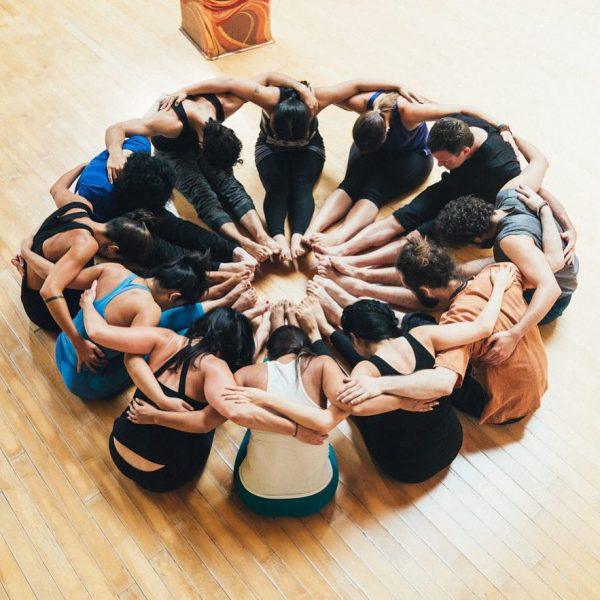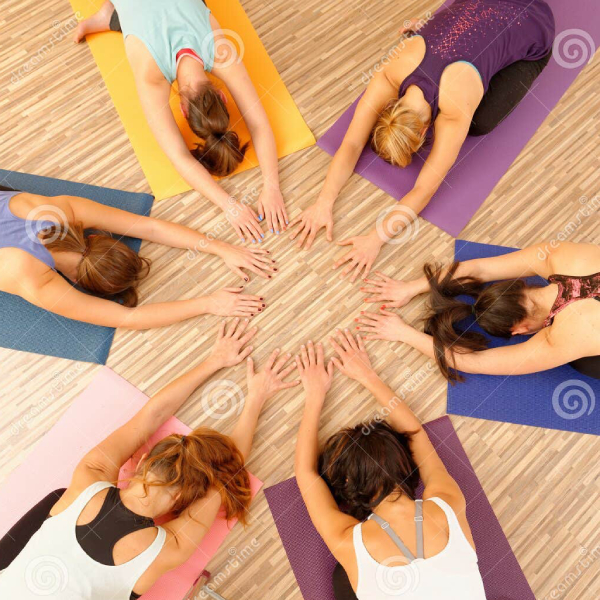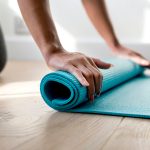Introduction to Yoga Circle
The yoga circle, often referred to simply as a yoga wheel, is a versatile tool designed to enhance your yoga practice. This circular prop helps in stretching, releasing tension, and improving flexibility. The yoga circle is suitable for both beginners and advanced yogis. It supports the body during various poses and can deepen stretches, making it a valuable addition to your yoga equipment.
Typically made from sturdy materials, the yoga circle withstands pressure and provides a firm grip. Its shape and design aim to match the natural curvature of the spine. This feature offers remarkable support during backbends and inversions. By using the yoga circle, practitioners can safely explore new poses and expand their yoga capabilities.

Incorporating the yoga circle into your routine can transform your practice. It opens up a new range of motion, gently guides your body into proper alignment, and helps you achieve poses that might have been challenging without support. As you continue to use the yoga wheel, you will notice enhanced strength, better balance, and a deeper overall understanding of your yoga journey.
Benefits of Using a Yoga Circle
The yoga circle is a remarkable tool that enhances various aspects of your yoga practice. This versatile prop not only aids in achieving deeper stretches but also contributes significantly to your overall wellness—both physically and mentally.
Physical Benefits
Integrating the yoga circle into your practice boosts your physical health in many ways. It can increase flexibility by allowing your body to go deeper into stretches. The supportive shape of the yoga circle is perfect for backbends and hip openers, reducing strain and the risk of injury. Regular use strengthens core muscles, improves balance, and enhances spine alignment. This supports better posture and reduces back pain. Using the yoga circle during exercises helps in building strength in hard-to-target muscle groups. Incorporating a yoga ball holder enhances stability during your practice, making it easier to achieve deeper stretches and better alignment. This aids in maximizing the benefits of the yoga circle.
Mental and Emotional Benefits
The benefits of using a yoga circle extend beyond physical improvements. The prop also plays a significant role in mental and emotional health. It encourages mindfulness as you focus on maintaining balance and alignment in poses. This concentration can deepen your meditation practice, helping to clear the mind and reduce stress. Emotionally, achieving new poses with the aid of the yoga circles can boost confidence and provide a sense of accomplishment. Moreover, the deep stretching and opening poses facilitated by the yoga circles can release pent-up emotional tension, promoting a sense of relaxation and well-being. Incorporating yoga ball crunches into your routine not only strengthens your core but also enhances mindfulness, contributing to improved mental and emotional health. Embrace this powerful combination for overall well-being.
Essential Yoga Circles Practices
Enhancing your yoga journey involves incorporating key practices with the yoga circle. Discover how this tool can redefine your routine and challenge your abilities.
Basic Poses with a Yoga Circle
For those starting out, it’s important to familiarize yourself with basic poses using the yoga circles. Here are some foundational practices:
- Circle-Assisted Child’s Pose: Deepen the traditional child’s pose by placing the yoga circle beneath your torso for added support.
- Wheel-Assisted Cobblers Pose: Sit with the soles of your feet together and the yoga circle supporting your spine for a gentle stretch.
- Circle-Enhanced Warrior Poses: Use the yoga circle to maintain balance and form in Warrior I or II.
These basic poses with the yoga circle help increase flexibility, support proper alignment, and build confidence in your practice.

Advanced Techniques
Once comfortable with the basics, explore advanced techniques to further benefit from the yoga circles:
- Backbend Over the Circle: Challenge your spine’s flexibility by draping over the yoga circles in a supported backbend.
- Inverted Poses with Support: Try supported headstands or shoulder stands using the yoga circles for guidance and stability.
- Deep Stretching Sequences: Integrate the yoga circles into sequences for deeper stretches and enhanced muscle engagement.
Advanced techniques with the yoga circles target specific muscle groups, enhance balance, and push the boundaries of your typical practice.
Integrating Yoga Circles in Daily Yoga Routine
Integrating the yoga circles into your daily routine can transform your yoga practice. It enhances flexibility, balance, and strength. Here’s how you can seamlessly include it:
- Start with a Warm-Up: Use the yoga circle during your warm-up sessions. Gentle stretches with the circle prepare your body for more intense poses.
- Integrate in Main Poses: During your main practice, use the yoga circle for poses like backbends or warriors. It provides the necessary support and deepens the stretch.
- Use for Cool Down: Employ the yoga circles in your cool-down routine. Poses like the supported child’s pose help relax and stretch the muscles deeply.
- Daily Flexibility Drills: Incorporate short sessions focused on flexibility, using the yoga circles to reach deeper into each stretch.
- Balance Training: Regularly practice standing or balancing poses using the yoga circles to enhance stability and core strength.
By integrating the yoga circles into your daily routine, you ensure a holistic yoga practice that touches on all aspects of physical and mental wellness. This routine continuity with the yoga circles will lead to noticeable improvements in flexibility, posture, and inner strength. Incorporating the best yoga ball into your routine enhances your practice, fostering better balance and core strength. This complements the benefits of the yoga circle for overall wellness.
Tips for Choosing the Right Yoga Circle
Choosing the right yoga circle is crucial for maximizing its benefits. Here are key factors to consider when selecting one for your practice.
Material and Durability
The material of the yoga circle affects its performance and longevity. Most yoga circles are made from high-quality, durable materials like ABS plastic or cork. ABS plastic is lightweight yet sturdy, making it ideal for routine use. Cork circles, on the other hand, offer a natural grip and are eco-friendly, but they can be heavier. Always check for a circle that can withstand significant weight and pressure without breaking.
Size and Shape Considerations
The size and shape of the yoga circles should complement your body dimensions and flexibility level. Standard yoga circles typically have a diameter of about 12 to 13 inches which suits most individuals. However, if you are particularly tall or have a larger body size, consider a larger diameter for better support. The width of the circle also plays a crucial role in how you perform the poses; a wider circle provides more stability and is preferable for beginners.
When considering size and shape, think about the types of exercises and yoga poses you plan to perform with the circle. A well-chosen yoga circle ensures comfort, enhances your performance, and prevents strain during complex poses.

Common Mistakes to Avoid
While the yoga circles offers many benefits, improper use can lead to less effective sessions or injuries. Here are some common mistakes to avoid:
- Using the Wrong Size: Choosing yoga circles that’s too small or too large can hinder your practices. Make sure the size fits your body type and flexibility level.
- Placing Improperly During Poses: Incorrect placement of the yoga circles can strain muscles. Always ensure it aligns correctly under your spine or limbs for support.
- Skipping Warm-Up: Jumping into complex poses with the yoga circle without a proper warm-up can lead to muscle injuries. Start with gentle stretches to prepare your body.
- Over-Relying on the Circle: While the yoga circles is helpful, relying on it too much can prevent the development of core strength and balance. Use it as a tool to enhance, not replace, your skills.
- Ignoring Pain: If you feel pain during a pose, stop immediately. Pain indicates incorrect posture or overstretching. Adjust your position or consult a professional.
By avoiding these mistakes, you can safely enjoy the benefits of using a yoga circles and progress in your yoga practices.
Examples of Effective Yoga Circles Sessions
To maximize the benefits of the yoga circle, here are some effective session examples:
- Full Body Stretch Routine: Begin with a 10-minute warm-up using gentle stretches. Progress to using the yoga circle for deeper stretches in poses like the supported bridge and the wheel-assisted forward fold. End with a relaxing cool down.
- Core Strengthening Series: Focus on strengthening the core by incorporating the yoga circles in poses like the plank and boat pose. Use the circle to maintain balance and increase the intensity of the exercise.
- Balance and Flexibility Workout: Combine balancing poses like the circle-assisted tree pose with flexibility exercises such as the circle-enhanced pigeon pose. This session aids in improving both balance and flexibility.
- Dynamic Flow Session: Integrate the yoga circles in a continuous flow of poses. Move from a circle-assisted warrior pose to a supported triangle pose, maintaining fluidity and rhythm.
- Restorative Yoga Session: Employ the yoga circles in restorative poses. Utilize it under the back in a reclined position or under the knees in a supine twist. This helps in deep relaxation and muscle recovery.
By incorporating these sessions into your routine, the yoga circle can significantly enhance your yoga practice, offering support and adding variety to your exercises.

